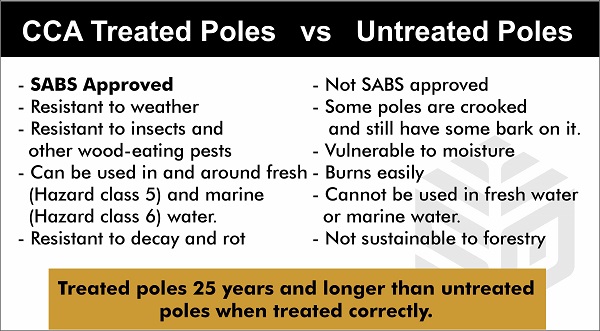It is true that untreated poles are cheaper, but surprisingly the price doesn’t really differ that much between CCA treated poles and untreated poles. At the end of the day, it’s more about high-quality-everlasting-product than pricing.
At Sabie Poles we make sure that we provide the best quality poles by having checks and balances in place for all our timber from the day that a seedling is planted until it is in our customer’s yard.
It is also important to us that our clients are well informed about our poles. In this blog we will be discussing the process of eucalyptus treated Poles and the difference between treated and untreated poles.
From a normal eucalyptus tree to a first-class Pole
Eucalyptus poles arriving at our CCA pressure treatment plant go into our grading and quality control system which adheres to the SABS 457 specification. Our quality control team makes sure that only the best eucalyptus poles are accepted.
We pack the selected poles onto the trolleys and then they are winched into the pressure vessel, which is sealed air-tight. A chemical called CCA is pressurised into the cells of the timber at a very high pressure ensuring that all or most of the pole’s sapwood is penetrated with this highly effective chemical.
Grading timber
Timber grading is an important key to ensure high-quality product. Here are a few factors that are important when grading is done:
- Poles must be straight
- Poles must have the correct diameters
- No cracks/splits
- Knots should be tight and not protruding
- No wane/bark is allowed
- Poles must not have any mechanical damage.
- Poles must have sufficient sapwood (soft part) for chemical to penetrate.
- Eucalyptus poles must have a moisture content of less than 35% before it can be treated.
Deciding between treated poles and untreated poles (Makappas)
Untreated, ungraded poles, more specifically, Eucalyptus species 6.0m 50-75 mm which is better known as Makappas, is wood that is used in its natural state in informal building projects. No preservatives are added whatsoever. So, one would think as it is a natural product, that it is sustainable for nature, which is a good thing. But just as natural as it sits right there, it is also most vulnerable to other natural elements such as insects, fungi etc. Makappas are also cheaper and more affordable to the informal market than CCA-treated poles. You would pay around R60 – R80 per 6m for untreated Makappas whereas you would pay around R120 per 6m for CCA treated poles.
If you really want to build a home or product with a quality that will last you a lifetime, it is not ideal to go for the cheapest option. When you build a home, where you would want to raise your kids and grandkids in, you would expect it to last a lifetime. This is where we highly recommend you put your money into the quality that you deserve. Don’t get us wrong, there are many great things you can do with untreated wood. But if long-lasting high-quality is what you are looking for, CCA-pressure treated poles is the way to go.

Risk factors of untreated timber
There are various factors that can contribute to the deterioration of your poles.
While you can use untreated timber for various structures, you are risking the structural integrity of your building. This is because there are various factors that contribute to the process of decay of your timber.
This is especially important if you are planning on building any type of structure inside or outside of the house. As a buyer or seller of wood, you need to be aware of these factors to prevent them.
- Fungi Decay – Fungi feed on the cell walls, thereby weakening the structure of the wood that leads to wood breakages and even crumbling
- Wood borers – Early identification of wood borers is vital to reducing the deterioration of wood. If not spotted it can have devastating effects on your materials.
- Termites – termites will not only speed up the deterioration of wood, but they will attack any cellulose-based products.
- Crustacea – These are not as worrisome as other wood borers but can still be harmful enough to affect the structural integrity of your wood.
- Weathering – The timber loses its natural colour and becomes a duller grey-white colour. This is due to the fact that UV-Rays, in particular, are impacting the polymer bonds within the wood substrate (cellulose, hemicelluloses and lignin). Additionally, the degradation of these cells means that they become loose and eventually starts eroding the wood’s surface.
- Not SABS approved
- Only lasts up to 3 years if well taken care of
- Some poles are crooked and still have some bark on it.
- Vulnerable to moisture
- Burns easily
- Cannot be used in fresh water or marine water.
- Not sustainable to forestry
Benefits of CCA Pressure Treated Eucalyptus Poles
- SABS Approved
- Resistant to weather
- Lasts up to 30 years when treated correctly
- Resistant to insects and other wood-eating pests
- Can be used in and around fresh (Hazard class 5) and marine (Hazard class 6) water.
- Resistant to decay and rot
- Does not leach chemicals into the ground or water when treated correctly, because the chrome fixates it into the timber cells.
- Affordable
- Poles have a neat finish
- Gives you peace of mind knowing your construction will last
- Contributes to sustainable forestry.
- Maintenance free
CCA pressure treated Poles are the most sought-after poles in the building, fencing, agricultural and outdoor construction industry. This fact only is pure proof that this treatment meets the highly expected standard quality required and more.
To view our pricelist on poles, please follow the following link: CCA Poles – Pressure Treated Gum Poles – Sabie Poles


